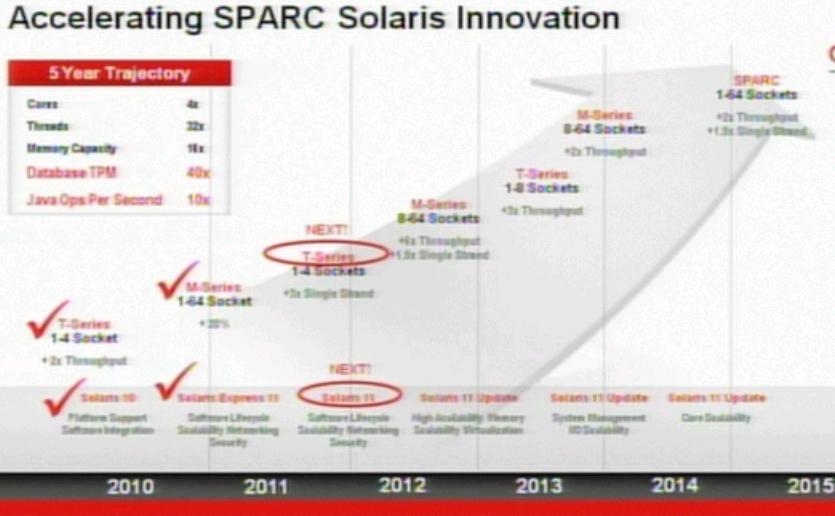
[UltraSPARC T3 Micrograph]
CoolThreads UltraSPARC and SPARC Processors
Abstract:
Processor development takes an immense quantity of time, to architect a high-performance solution, and an uncanny vision of the future, to project market demand and acceptance. In 2005, Sun embarked on a bold path moving toward many cores and many threads per core. Since the purchase of Sun by Oracle, the internal SPARC road map from Sun had clarified.

[UltraSPARC T1 Micrograph]
Generation 1: UltraSPARC T1
A new family of SPARC processors was announced by Sun on 2005 November 14.
- Single die
- Single socket
- 64 bits
- 4, 6, 8 integer cores
- 4, 6, 8 crypto cores
- 4 threads/core
- 1 shared floating point core
- 1.0 GHz - 1.4 GHz clock speed
- 279 million transisters
- 378 mm2
- 90 nm CMOS (TI)
- 1 JBUS port
- 3 Megabyte Level 2 Cache
- 1 Integer ALU per Core
- ??? Memory Controllers
- 6 Stage Integer Pipeline per Core
- No embedded Ethernet into CPU
- Crypto Algorithms: ???
To understand the ground-breaking advancement in this technology, most processors were single core, with an occasional dual core processor (with cores glued together through a more expensive process referred to as a multi-chip module, driving higher software licensing costs for those platforms.)

Generation 2: UltraSPARC T2
The next generation of the CoolThreads processor was announced by Sun on 2007 August.
- Single die
- Single Socket
- 64 bits
- 4, 6, 8 integer cores
- 4, 6, 8 crypto cores
- 4, 6, 8 floating point units
- 8 threads/core
- 1.2 GHz - 1.6 GHz clock speed
- 503 million transisters
- 342 mm2
- 65 nm CMOS (TI)
- 1 PCI Express port (1.0 x8)
- 4 Mageabyte Level 2 Cache
- 2 Integer ALU per Core
- 4x Dual Channel FBDIMM DDR2 Controllers
- 8 Stage Integer Pipeline per Core
- 2x 10 GigabitEthernet on-CPU ports
- Crypto Algorithms: DES, Triple DES, AES, RC4, SHA1, SHA256, MD5, RSA-2048, ECC, CRC32
Competitors started to build Single-Die dual-core CPU's with Quad-Core processors by gluing dual-core processors into a Multi-Chip Module.

[UltraSPARC T2 Micrograph]
Generation 3: UltraSPARC T2+
Sun quickly released the first CoolThreads SMP capable UltraSPARC T2+ in 2008 April.
- Single die
- 1-4 Sockets
- 64 bits
- 4, 6, 8 integer cores
- 4, 6, 8 crypto cores
- 4, 6, 8 floating point units
- 8 threads/core
- 1.2 GHz - 1.6 GHz clock speed
- 503 million transisters
- 342 mm2
- 65 nm CMOS (TI)
- 1 PCI Express port (1.0 x8)
- 4 Megabyte Level 2 Cache
- 2 Integer ALU per Core
- 2x? Dual Channel FBDIMM DDR2 Controllers
- 8? Stage Integer Pipeline per Core
- No embedded Ethernet into CPU
- Crypto Algorithms: DES, Triple DES, AES, RC4, SHA1, SHA256, MD5, RSA-2048, ECC, CRC32
By this time, competition really started to understand that Sun had properly predicted the future of computing. The drive toward single-die Quad-Core chips have started with Hex-Core Multi-Chip Modules being predicted.

Generation 4: SPARC T3
The market became nervous with Oracle purchasing Sun. The first Oracle branded CoolThreads SMP capable UltraSPARC T3 was launched in in 2010 September.
- Single die
- 1-4 Sockets
- 64 bits
- 16 integer cores
- 16 crypto cores
- 16 floating point units
- 8 threads/core
- 1.67 GHz clock speed
- ??? million transisters
- 377 mm2
- 40 nm
- 2x PCI Express port (2.0 x8)
- 6 Megabyte Level 2 Cache
- 2 Integer ALU per Core
- 4x DDR3 SDRAM Controllers
- 8? Stage Integer Pipeline per Core
- 2x 10 GigabitEthernet on-CPU ports
- Crypto Algorithms: DES, 3DES, AES, RC4, SHA1, SHA256/384/512, Kasumi, Galois Field, MD5, RSA to 2048 key, ECC, CRC32
The market, immediately before this release, the competition was releasing single die hex-core and octal-core CPU's using multi-chip modules, by gluing them together. The T3 was a substantial upgrade over the competition by offering double the cores on a single die.

Generation 5: SPARC T4
Oracle indicated in December 2010 that they had thousands of these processors in the lab and predicted this processor will be released end of 2011.
After the announcement, a separate press release indicated processors will have a renovated core, for higher single threaded performance, but the socket will offer half the cores.
Most vendors are projected to have 8 core processors available (through Multi-Chip modules) by the time the T3 is released, but only the T4 should be on a single piece of silicon during this period.

[2010-12 SPARC Solaris Roadmap]
Generation 6: SPARC T5
Some details on the T5 were announced with the T4. Processors will use the renovated T4 core, with a 28nm process. This will return to 16 cores per socket again. This processor may be the first Coolthreads T processor able to scale from 1-8 processors. It is projected to appear in early 2013.
Some vendors are projecting to have 12 core processors on the market using Multi-Chip Module technology, but when the T5 is released, this should still be the market leader in 16 cores per socket.
Network Management Connection
Consolidating most network management stations in a globalized environment works very well with the Coolthreads T-Series processors. Consolidating multiple slower SPARC platforms onto single and double socket T series have worked well over the past half decade.
While most network management polling engines will scale linearly with these highly-threaded processors, there are some operations which are bound to single threads. These type of processes include event correlation, startup time, and syncronization after a discovery in a large managed topology.
The market will welcome the enhanced T4 processor core and the T5 processor, when it is released.
No comments:
Post a Comment